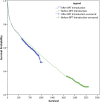Does achieving the best practice tariff improve outcomes in hip fracture patients? An observational cohort study
- PMID: 28167748
- PMCID: PMC5293976
- DOI: 10.1136/bmjopen-2016-014190
Does achieving the best practice tariff improve outcomes in hip fracture patients? An observational cohort study
Abstract
Objectives: To determine if the introduction of the best practice tariff (BPT) has improved survival of the elderly hip fracture population, or if achieving BPT results in improved survival for an individual.
Setting: A single university-affiliated teaching hospital.
Participants: 2541 patients aged over 60 admitted with a neck of femur fracture between 2008 and 2010 and from 2012 to 2014 were included, to create two cohorts of patients, before and after the introduction of BPT. The post-BPT cohort was divided into two groups, those who achieved the criteria and those who did not.
Primary and secondary outcome measures: Primary outcomes of interest were differences in mortality across cohorts. Secondary analysis was performed to identify associations between individual BPT criteria and mortality.
Results: The introduction of BPT did not significantly alter overall 30-mortality in the hip fracture population (8.3% pre-BPT vs 10.0% post-BPT; p=0.128). Neither was there a significant reduction in length of stay (15 days (IQR 9-21) pre-BPT vs 14 days (IQR 11-22); p=0.236). However, the introduction of BPT was associated with a reduction in the time from admission to theatre (median 44 hours pre-BPT (IQR 24-44) vs 23 hours post-BPT (IQR 17-30); p<0.005). 30-day mortality in those who achieved BPT was significantly lower (6.0% vs 21.0% in those who did not achieve-BPT; p<0.005). There was a survival benefit at 1 year for those who achieved BPT (28.6% vs 42.0% did not achieve-BPT; p<0.005). Multivariate logistic regression revealed that of the BPT criteria, AMT monitoring and expedited surgery were the only BPT criteria that significantly influenced survival.
Conclusions: The introduction of the BPT has not led to a demonstrable improvement in outcomes at organisational level, though other factors may have confounded any benefits. However, patients where BPT criteria are met appear to have improved outcomes.
Keywords: ORTHOPAEDIC & TRAUMA SURGERY.
Published by the BMJ Publishing Group Limited. For permission to use (where not already granted under a licence) please go to http://www.bmj.com/company/products-services/rights-and-licensing/.
Conflict of interest statement
Competing interests: None declared.
Figures
References
-
- Royal College of Physicians. National Hip Fracture Database annual report 2016. London: RCP, 2016.
Publication types
MeSH terms
LinkOut - more resources
Full Text Sources
Other Literature Sources
Medical
Miscellaneous


